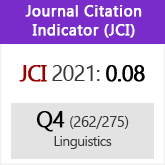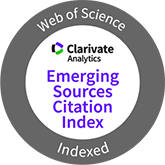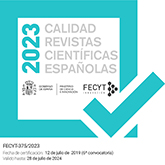The role of the input frequency in L1 Spanish phonological acquisition. A corpus-based study
DOI:
https://doi.org/10.3989/loquens.2022.e089Keywords:
L1 acquisition, phonological development, input frequency, corpusAbstract
This study presents the phonological system exhibited by children (n=59) aged 3;0 to 6;0 and focuses on the role of input frequency. Using a spontaneous child speech corpus of Spanish (CHIEDE) as a data source, as well as computational processing techniques -including an automatic phonological transcriber-, data relating to the phonological level was retrieved. This resulted in a phonological inventory of Spanish-speaking children, ordered by frequency of use, which may serve as a model for research on typical and atypical child language development. Additionally, a study was carried out on the stability of the participants’ phonological systems by calculating the variability that the different age groups displayed, and outcomes were compared with other similar corpora. Results obtained from the comparison of the phonological inventory of children and adults show that there is a relationship between frequency of use in adult speech and the order of acquisition of phonemes.
Downloads
References
Acevedo, M. A. (1993). Development of Spanish consonants in preschool children. Communication Disorders Quarterly, 15(2), 9-15. https://doi.org/10.1177/152574019301500202
Acosta, V., & Ramos, V. (1998). Estudio de los desórdenes del habla infantil desde la perspectiva de los procesos fonológicos. Revista de Logopedia, Fonatría y Audiología, 18, 124-142. https://doi.org/10.1016/S0214-4603(98)75683-9
Albalá, M. J., & Marrero, V. (2004). Spanish Marrero Corpus. TalkBank. https://childes.talkbank.org/access/Spanish/Marrero.html
Benedet, M., & Snow, K. (2004). Spanish BecaCESNo Corpus. TalkBank. https://childes.talkbank.org/access/Spanish/BecaCESNo.html
Bernhardt, B. M., & Stemberger, J. P. (2017). Investigating typical and protracted phonological development across languages. In E. Babatsouli, D. Ingram, & N. Müller (Eds.), Crosslinguistic Encounters in Language Acquisition: Typical and Atypical Development (pp. 71-108). Multilingual Matters. https://doi.org/10.21832/9781783099092-008
Bernstein-Ratner, N. (1994). Phonological analysis of child speech. In J. L. Sokolov, & C.E. Snow (Eds.), Handbook of research in language development using CHILDES (pp. 324-372). Hillsdale, NJ: Lawrence Erlbaum Associates.
Bleses, D., Basbøll, H., Lum, J., & Vach, W. (2010). Phonology and lexicon in a cross-linguistic perspective: the importance of phonetics - a commentary on Stoel-Gammon's "Relationships between lexical and phonological development in young children". Journal of Child Language ,38(01), 61-68. https://doi.org/10.1017/S0305000910000437 PMid:20950496
Bosch, L. (1983). El desarrollo fonológico infantil: una prueba para su evaluación. Anuario de Psicología, 28(1), 87-114.
Bosch, L., & Sebastián-Gallés, N. (2001). Evidence of early language discrimination abilities in infants from bilingual environments. Infancy, 2, 29-49. https://doi.org/10.1207/S15327078IN0201_3 PMid:33451225
Bosch, L., & Sebastián-Gallés, N. (2003). Language experience and the perception of a voicing contrast in fricatives: infant and adult data. In M. J. Solé, D. Recasens, & J. Romero (Eds.), Proceedings of the Fifteenth International Congress of Phonetic Sciences (pp. 1987-1990). Universitat Autónoma de Barcelona.
Bunta, F., & Ingram, D. (2007). The acquisition of speech rhythm by bilingual Spanish-and English-speaking 4-and 5-year-old children. Journal of Speech, Language, and Hearing Research, 50(4), 999-1014. https://doi.org/10.1044/1092-4388(2007/070) PMid:17675601
Carreira, M. (1991). The acquisition of Spanish syllable structure. In D. Wanner, & D. A. Kibbee (Eds.), New analyses in Romance linguistics (pp. 3-18). John Benjamins. https://doi.org/10.1075/cilt.69.06car
Chomsky, N. (1980). Rules and representation. MIT Press. https://doi.org/10.1017/S0140525X00001515
Demuth, K. (2009). The prosody of syllables, words and morphemes. In E. L. Bavin (Ed.), The Cambridge Handbook of Child Language (pp. 183-198). Cambridge University Press. https://doi.org/10.1017/CBO9780511576164.011
Díez-Itza, E. (1995). Procesos fonológicos en la adquisición del español como lengua materna. In J. M. Ruiz, P. H. Sheerin, & E. González-Cascos (Eds.), Actas del XI Congreso Nacional de Lingüística Aplicada (pp. 225-264). Universidad de Valladolid.
Díez-Itza, E., & Martínez López, V. (2004). Las etapas tardías de la adquisición fonológica: procesos de reducción de grupos consonánticos. Anuario de Psicología, 35, 177-202.
Dolgova, N., & Tyler, A. (2019). Applications of Usage-Based Approaches to Language Teaching. In X. Gao (Ed.), Second Handbook of English Language Teaching (pp. 939-961). Springer. https://doi.org/10.1007/978-3-030-02899-2_49
Durgunoğlu, A. Y., & Öney, B. (1999). A cross-linguistic comparison of phonological awareness and word recognition. Reading and Writing: An Interdisciplinary Journal, 11, 281-299. https://doi.org/10.1023/A:1008093232622
Ellis, N. C. (2008). Usage-based and form-focus SLA: The implicit and explicit learning of constructions. In A. Tyler, Y. Kim, & M. Takada (Eds.), Language in the Context of Use: Discourse and Cognitive Approaches to Language, (pp. 93-120). New York: Mouton de Gruyter. https://doi.org/10.1515/9783110199123.1.93
Ellis, N. C. (2017). Cognition, Corpora, and Computing: Triangulating Research in Usage-Based Language Learning. Language Learning, 67(S1), 40-65. https://doi.org/10.1111/lang.12215
Garrote, M. (2010). Los corpus de habla infantil. Metodología y análisis. Servicio de publicaciones de la Universidad Autónoma de Madrid.
Goldstein, B., & Cintrón, P. (2001). An investigation of phonological skills in Puerto-Rican Spanish-speaking 2-year-olds. Clinical Linguistics and Phonetics, 15, 343-361. https://doi.org/10.1080/02699200010017814
Goodman, J. C., Dale, P. S., & Li, P. (2008). Does frequency count? Parental input and the acquisition of vocabulary. Journal of Child Language, 35, 515-531. https://doi.org/10.1017/S0305000907008641 PMid:18588713
Grunwell, P. (1981). The development of phonology: A descriptive profile. First language, 3, 161-191. https://doi.org/10.1177/014272378100200601
Hedlund, G., & Rose, Y. (2020). Phon 3.1 [Computer Software]. https://phon.ca.
Ingram, D. (1976). Phonological disability in children. Edwards Arnold.
Ingram, D. (1979). Phonological patterns in the speech of young children. In P. Fletcher, & M. Garman (Eds.), Language acquisition (pp. 133-149). Cambridge University Press.
Ingram, D. (2002). The measurement of whole-word productions. Journal of Child Language, 29, 713-733. https://doi.org/10.1017/S0305000902005275 PMid:12471970
Jimenez, B. C. (1987). Acquisition of Spanish consonants in children aged 3-5 years, 7 months. Language, Speech, and Hearing Services in Schools, 18(4), 357-363. https://doi.org/10.1044/0161-1461.1804.357
Kehoe, M., & Lleó, C. (2003). The acquisition of syllable types in monolingual and bilingual German and Spanish children. In B. Beachley, A. Brown, & F. Conlin (Eds.), Proceedings of the Twenty-seventh annual Boston University Conference on Language Development (pp. 402-413). Cascadilla Press.
Kehoe, M., & Lleó, C. (2005). The emergence of language specific rhythm in German-Spanish bilingual children. Arbeiten zur Mehrsprachigkeit: Working Papers in Multilingualism, 58. SFB 538.
Kehoe, M., Lleó, C., & Rakow, M. (2004). Voice onset time in bilingual German-Spanish children. Bilingualism: Language and Cognition, 7, 71-88. https://doi.org/10.1017/S1366728904001282
Kern, S., Gayraud, F., & Chenu, F. (2014). The role of input in early first language morphosyntactic development. Language, Interaction and Acquisition, 5(1), 1-18. https://doi.org/10.1075/lia.5.1.00int
Kouti, M. (2010). Problemas perceptivos de la estructura silábica del español por aprendices griegos de E/LE. Revista electrónica de didáctica. Español lengua extranjera (redELE), 19, 19-36.
Lleó, C. (2002). The role of markedness in the acquisition of complex prosodic structures by German-Spanish Bilinguals. International Journal of Bilingualism, 6, 291-313. https://doi.org/10.1177/13670069020060030501
Lleó, C. (2003). Prosodic licensing of coda in the acquisition of Spanish. Probus, 15, 257-281. https://doi.org/10.1515/prbs.2003.010
Lleó, C. (2006). The acquisition of prosodic word structures in Spanish by monolingual and Spanish-German bilingual children. Language and Speech, 49, 205-229. https://doi.org/10.1177/00238309060490020401 PMid:17037122
Lleó, C. (2012). First language acquisition of Spanish sounds and prosody. In J. I. Hualde, A. Olarrea, & E. O'Rourke (Eds.), The Handbook of Hispanic Linguistics (pp. 693-710). Blackwell Publishing Ltd. https://doi.org/10.1002/9781118228098.ch32
López Valero, A., Carrillo Hernández, M. R., & Ros Frutos, J. L. (1989). Aportaciones para el estudio del desarrollo del lenguaje infantil en el período comprendido entre los veinticuatro y los treinta meses. Cauce, Revista de Filología y su Didáctica, 12, 145-156.
MacWhinney, B. (1996). Computational analysis of interactions. In P. Fletcher, & B. MacWhinney (Eds.), The Handbook of child language (pp. 152-178). Blackwell. https://doi.org/10.1111/b.9780631203124.1996.00006.x PMid:28713191
MacWhinney, B., & Snow, C. (1985). The child language data exchange system. Journal of Child Language, 12(2), 271-295. https://doi.org/10.1017/S0305000900006449 PMid:4019604
Maekawa, J., & Storkel, H. L. (2006). Individual differences in the influence of phonological characteristics on expressive vocabulary development by young children. Journal of Child Language, 33, 439-459. https://doi.org/10.1017/S0305000906007458 PMid:17017275 PMCid:PMC1618766
Maratsos, M. P. (1974). Children who get worse at understanding the passive: A replication of Bever. Journal of Psycholinguistic Research, 3(1), 65-74. https://doi.org/10.1007/BF01067222
Martínez Celdrán, E., Fernández Planas, A. M., & Carrera Sabaté, J. (2003). Castilian Spanish. Journal of the International Phonetic Association, 33(2), 255-259. https://doi.org/10.1017/S0025100303001373
McEnery, T., & Wilson, A. (2001). Corpus linguistics: An introduction. University Press.
McLeod, S., & Crowe, K. (2018). Children's Consonant Acquisition in 27 Languages: A Cross-Linguistic Review. American Journal of Speech-Language Pathology, 27(4), 1546-1571. https://doi.org/10.1044/2018_AJSLP-17-0100 PMid:30177993
Melgar de González, M. (1976). Cómo detectar al niño con problemas de habla. Trillas.
Menn, L., & Stoel-Gammon, C. (1996). Phonological development. In P. Fletcher, & B. MacWhinney (Eds.), The Handbook of child language (pp. 335-359). Blackwell. https://doi.org/10.1111/b.9780631203124.1996.00014.x
Mines, M. A., Hanson, B. F., & Shoup, J. E. (1978). Frequency of occurrence of phonemes in conversational English. Language and speech, 21(3), 221-241. https://doi.org/10.1177/002383097802100302 PMid:732398
Moreno Cabrera, J. C. (1997). Introducción a la lingüística: enfoque tipológico y universalista. Síntesis.
Moreno Sandoval, A., Torre Toledano, D., De La Torre, R., Garrote, M., & Guirao, J. M. (2008). Developing a phonemic and syllabic frequency inventory for spontaneous spoken Castilian Spanish and their comparison to text-based inventories. Proceedings of the VI Language Resources and Evaluation Conference (LREC), 1097-1100.
Piaget, J. (1926). The language and thought of the child. Kegan Paul, Trench & Trubner.
Pierrehumbert, J. B. (2003). Probabilistic theories of phonology. In R. Bod, J. Hay, & S. Jannedy (Eds.), Probability Theory in Linguistics (pp. 177-228). The MIT Press. https://doi.org/10.7551/mitpress/5582.003.0009
Polo, N. (2016). La investigación actual sobre el desarrollo de la fonología del español como lengua materna. Lenguas modernas, 47, 137-152.
Pye, C. L., Ingram, D., & List, H. (1987). A comparison of initial consonant acquisition in English and Quiché. In K. Nelson, & A. Van Kleeck (Eds.), Children's Language (Vol. 6) (pp. 175-190). Erlbaum. https://doi.org/10.4324/9781315792668-8
Roark, B., & Demuth, K. (2000). Prosodic constraints and the learners's environment: a corpus study. In Howell, S. Catherine, Sara A. Fish & Thea Keith-Lucas (Eds.). Proceedings of the 24th Annual Boston University Conference on Language Development. Vol. 2 (pp. 597-608). Cascadilla Press.
Rose, Y. (2009). Internal and External Influences on Child Language Productions. In Pellegrino, François, Egidio Marsico, Ioana Chitoran, & Christophe Coupé (Eds.), Approaches to Phonological Complexity (pp. 329-351). Mouton de Gruyter. https://doi.org/10.1515/9783110223958.329
Serra, M. (1983). Normas estadísticas de articulación para la población escolar de 3 a 7 años en el área metropolitana de Barcelona. Revista de Logopedia, Foniatría y Audiología, 3(4), 232-235. https://doi.org/10.1016/S0214-4603(83)75286-1
Stampe, D. (1969). The acquisition of phonetic representation. In R. I. Binnick, A. Davidson, G. Green, & J. L. Morgan (Eds.), Papers from the Fifth Regional Meeting of the Chicago Linguistic Society (pp. 443-454). Chicago Linguistic Society.
Stoel-Gammon, C. (2006). Infancy: phonological development. Encyclopaedia of Language & Linguistics (Second Edition), 642-648. https://doi.org/10.1016/B0-08-044854-2/00838-5
Stoll, S. (2009). Crosslinguistic approaches to language acquisition. In E. L. Bavin (Ed.), The Cambridge Handbook of Child Language (pp. 89-104). Cambridge University Press. https://doi.org/10.1017/CBO9780511576164.006
Tomasello, M. (2003). Constructing a language: A usage-based theory of language acquisition. Harvard University Press.
Valian, V. (2009). Innateness and learnability. In E. Bavin, (Ed.), The Cambridge handbook of language acquisition (pp. 15-34). Cambridge University Press. https://doi.org/10.1017/CBO9780511576164.002
Velleman, S. L., & Vihman, M. M. (2002). Whole-Word Phonology and Templates. Language Speech and Hearing Services in Schools, 33(1), 9-23 https://doi.org/10.1044/0161-1461(2002/002) https://doi.org/10.1044/0161-1461(2002/002) PMid:27764418
Vihman, M. M., DePaolis, R. A, & Keren-Portnoy, T. (2009). A dynamic systems approach to babbling and words. In E. L. Bavin (Ed.), The Cambridge Handbook of Child Language (pp. 163-182). Cambridge University Press. https://doi.org/10.1017/CBO9780511576164.010
Vihman, M., & Wauquier, S. (2018). Templates in child language. In M. Hickmann, E, Veneziano, & H. Jisa (Eds.), Sources of variation in first language acquisition: Languages, contexts, and learners (pp. 27-44). John Benjamins Publishing Company. https://doi.org/10.1075/tilar.22.02vih
Zamuner, T. (2009). The structure and nature of phonological neighbourhoods in children's early lexicons. Journal of Child Language, 36, 3-21. https://doi.org/10.1017/S0305000908008829 PMid:18808731
Zamuner, T., LouAnn, S., & Gerken y Hammond, M. (2004). Phonotactic probabilities in young children's speech production. Journal of Child Language 31, 515-36. https://doi.org/10.1017/S0305000904006233 PMid:15612388
Published
How to Cite
Issue
Section
License
Copyright (c) 2023 Consejo Superior de Investigaciones Científicas (CSIC)

This work is licensed under a Creative Commons Attribution 4.0 International License.
© CSIC. Manuscripts published in both the printed and online versions of this Journal are the property of Consejo Superior de Investigaciones Científicas, and quoting this source is a requirement for any partial or full reproduction.All contents of this electronic edition, except where otherwise noted, are distributed under a “Creative Commons Attribution 4.0 International” (CC BY 4.0) License. You may read here the basic information and the legal text of the license. The indication of the CC BY 4.0 License must be expressly stated in this way when necessary.
Self-archiving in repositories, personal webpages or similar, of any version other than the published by the Editor, is not allowed.
Funding data
Ministerio de Ciencia, Innovación y Universidades
Grant numbers FFI2017-82752-P
European Regional Development Fund
Grant numbers FFI2017-82752-P















